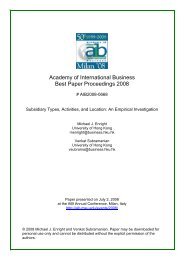AIB 2012 Conference Proceedings - Academy of International ...
AIB 2012 Conference Proceedings - Academy of International ...
AIB 2012 Conference Proceedings - Academy of International ...
You also want an ePaper? Increase the reach of your titles
YUMPU automatically turns print PDFs into web optimized ePapers that Google loves.
TUESDAY<br />
Asymmetry in knowledge spillovers between technology leading and lagging firms provides incentives for<br />
technology leaders to discourage other firms from setting up new R&D establishments in their vicinity, in order<br />
to reduce the threat <strong>of</strong> knowledge dissipation. We examine whether the presence <strong>of</strong> local technology leaders<br />
discourages inward R&D investments, in an analysis <strong>of</strong> the location <strong>of</strong> 301 cross-border R&D investment<br />
projects in EU-15 countries at the NUTS-1 regional level, 2003-2008. We identify the strength <strong>of</strong> industry<br />
technology leaders as dominant players in regional R&D from the concentration <strong>of</strong> regional patenting activity<br />
among local firms and control for the size <strong>of</strong> the regional technology cluster. Our preliminary results clearly<br />
indicate that while the strength <strong>of</strong> local relevant technology clusters attracts cross-border R&D projects,<br />
investors are discouraged by concentration <strong>of</strong> technology activities by regional industry leaders. Distinguishing<br />
between firms with the largest patent portfolios and firms with smaller patent activity, we find that these effects<br />
are only significant for smaller firms, indicating substantial firm heterogeneity in the responses to technology<br />
clusters and technology concentration. (For more information, please contact: Dieter Somers, Katholieke<br />
Universiteit Leuven, Belgium: dieter.somers@econ.kuleuven.be)<br />
The Dual External Embeddedness <strong>of</strong> Geographically Distributed R&D<br />
Suma Athreye, Brunel University<br />
Georgios Batsakis, Brunel University<br />
Satwinder Singh, Brunel University<br />
We develop the conjecture that an R&D subsidiary can embed itself in the science base <strong>of</strong> the home country<br />
(more closely controlled by the parent) and/or the science base <strong>of</strong> the host country, depending upon the type <strong>of</strong><br />
R&D it is mandated to perform, the threat <strong>of</strong> R&D leakage, strategic considerations <strong>of</strong> rival firms, and the<br />
characteristics <strong>of</strong> the host country's business environment and scientific endowments. We test these conjectures<br />
on data obtained from 76 R&D subsidiaries in 14 international locations. Both types <strong>of</strong> external embeddedness<br />
are important and complementary. Global competitors and location specific advantages have determine the<br />
extent <strong>of</strong> host country embeddedness, but location specific disadvantages, geographical proximity to the parent<br />
and relative autonomy in subsidiary operations favour external embeddedness in the parent country networks.<br />
(For more information, please contact: Georgios Batsakis, Brunel University, United Kingdom:<br />
georgios.batsakis@brunel.ac.uk)<br />
Dynamic Capabilities and Subsidiary Innovation: Towards an Integrative Framework<br />
Zhan Wu, University <strong>of</strong> Sydney<br />
Snejina Michailova, University <strong>of</strong> Auckland<br />
This conceptual paper borrows the concept <strong>of</strong> dynamic capabilities from the strategic management literature<br />
and applies it to the examination <strong>of</strong> subsidiary innovation in global context. The paper proposes an integrative<br />
framework which a) differentiates between generative, sourcing and integrative capabilities, b) relates these to<br />
the new proposed construct <strong>of</strong> dynamic knowledge capability and c) establishes a link between dynamic<br />
knowledge capability and subsidiary innovation. The framework addresses the levels <strong>of</strong> subsidiary, the<br />
multinational corporation and the host country. A set <strong>of</strong> theoretical propositions is developed and research and<br />
managerial implications as well as future research are discussed. (For more information, please contact: Zhan<br />
Wu, University <strong>of</strong> Sydney, Australia: w.zhan@econ.usyd.edu.au)<br />
Session: 3.1.5 - Competitive<br />
Track: 6 - Innovation and Knowledge Mgmt.<br />
Knowledge Creation in the MNE<br />
Presented On: July 3, <strong>2012</strong> - 09:00-10:15<br />
Chair: Anupama Phene, George Washington University<br />
<strong>AIB</strong> <strong>2012</strong> <strong>Conference</strong> <strong>Proceedings</strong><br />
Page 190

















